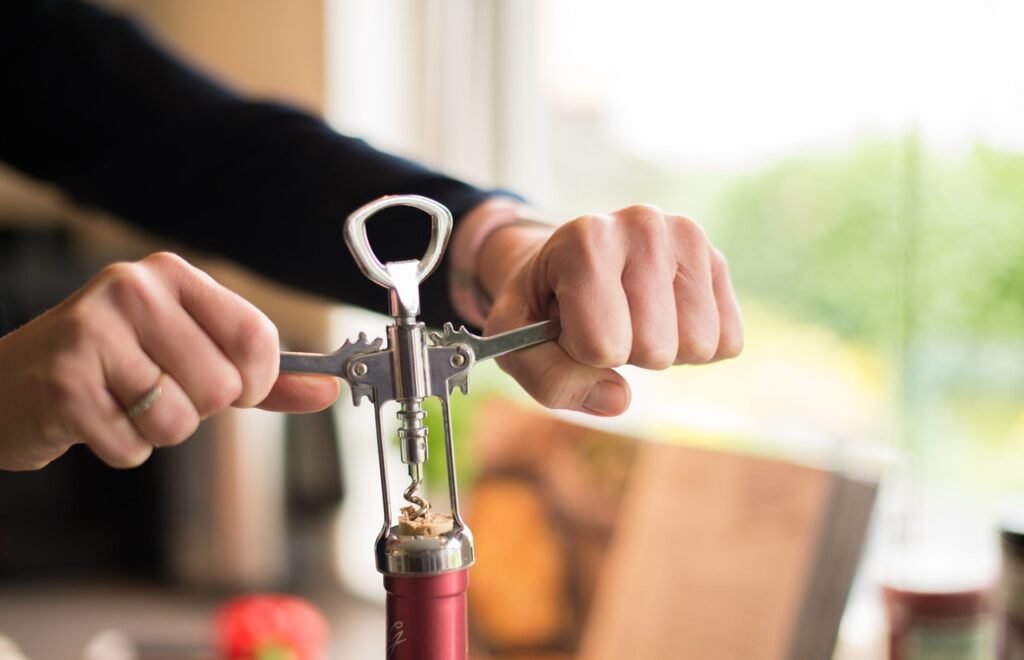Don’t let a single cork stand between you and a bottle of wine! There are many types of corkscrews, but most of them are pretty easy to use. The basic technique is to screw the metal spiral into the bottle’s cork, then take it out. Wine keys and winged corkscrews require a minimal amount of work, but basic corkscrews or travel variants may also be used in a pinch. Just remember to work softly, and in no time will you be pouring. Here’s how to use a lever wine opener.

Thanks to their ease of use, lever corkscrews are steadily gaining popularity. Most lever corkscrews need only two movements, one forward motion in which the worm is inserted into the cork and one that gently pulls the cork out of the bottle. The real advantage of using a lever corkscrew is the amount of leverage they have as the handle grips the bottle’s neck securely when the corkscrew is in use. These corkscrews are great for front-of-house use and have a compact size to keep hidden behind the bar.
Rabbit Concept (Lever)
They can take the cake for ease of use, short of an electrical one or a table-mounted one. In reality, the rabbit-style wine opener was named for the way it looked. But new ones that follow the same idea may or may not look the same as the original.
A rabbit-style corkscrew is basically a corkscrew that you clamp over the top of a bottle of wine (usually using the rabbit ear grip) and then pull the lever one way (inserting the worm mechanism) and force it back to its original location (pulling the cork out). It operates with the same method to reinsert the cork. Do you know how to use a lever wine opener?
More Information
In addition to reducing it to one lever, this device’s main advancement enables the person to open the bottle to manipulate the bottle (through the clamp). You press down the bottle with the winged corkscrew, and the resistance produced by the table underneath pushes the cork up. In reality, no one secures a bottle of wine directly.
The lever style often excels in how it reduces the amount of effort required by giving the lever a large range of motion. So the amount of effort would end up being considerably less. The lever design has changed, and now they look like they’re made of chrome or just a lever without any internal work.
Rabbit corkscrews use a lever-operated corkscrew to extract the cork from the wine bottle. Since they’re mechanized, rabbit corkscrews work with a minimum of twisting and pulling on your side. Instead, you open a bottle of wine by gripping a pair of handles and pulling a lever. Opening a rabbit corkscrew wine is faster and simpler than using a conventional corkscrew. You can enjoy your wine without having to struggle with the cork first.
How To Use A Lever Wine Opener

Remove the protective foil cover from the wine bottle with the foil cutter. Rabbit corkscrews are not meant to force the cork through the foil. If the bottle of wine has a wax seal, remove it as well.
Keep the rabbit corkscrew’s gripping handles in one hand and lift the lever with the other. The corkscrew is going to climb to an elevated position.
Center the corkscrew over the cork and lower the opening over the neck of the bottle. Squeeze the grip handles to mount the corkscrew to the bottle and retain a tight grip when extracting the cork.
Lift your lever. The corkscrew is going to dig into the cork. Take the lever down to slide the cork up and out of the bottle. Lose your hold on the gripping handles and raise the rabbit corkscrew out of the bottle.
Remove the cork from the corkscrew by raising the lever to lower the cork and the corkscrew. When the corkscrew is lowered, tighten the grip handles and pull the lever down. The cork is going to slip off the corkscrew.
How To Use A Lever Wine Opener: Double Lever Corkscrew
Double lever corkscrews are very easy to use. They are lightweight and fit well in your hand. The two-step lever action makes it easy to remove the cork from the bottle.
Most of them have a small foil cutter.
With a lot of different corkscrews available, the Double Lever Bottle Opener is by far the most common because of its usability. Here we demonstrated in our guide how to use a double lever corkscrew to help you extract the cork from a wine bottle.
Follow These Steps

You need to keep the wine bottle, preferably on a flat surface. To cut the foil, use a foil cutter. We suggest putting the foil cutter under the top of the bottle ridge, keeping it in place, and twisting the bottle with the other hand. This should split the foil that gives you one piece still on the bottle and the other one free, just remove it!
Now put the screw (worm) into the cork, turn the corkscrew into the cork.
Screw into the cork, leaving just two or three spirals on the corkscrew (this is to avoid piercing the cork at the other end). Place the lever on the neck of the bottle, raise the corkscrew up until the second lever is in line with the neck of the bottle.
Now put the second lever on the neck of the bottle and repeat the operation. The cork should be released now, but if it is not a tug on the corkscrew, the cork should be released.
In just two moves, the worm inserts itself into the cork and gently pulls it out. There is also a lot of leverage when using these corkscrews, as the handles tightly hold the neck of the bottle as the bottle opens. There are several different types of these lever type corkscrews available from plastic to die-cast metal. However, if you choose to drink wines that usually use synthetic corks, make sure you choose one of the more robust choices because not all of them can work with these corks.
Final Words
Rabbit wine openers are commonly available and come with acceptable guarantees. They are not the least expensive wine-openers on the market, but they have a reputation for being high-quality, long-lasting products. The majority of the reviews are positive and extoll the ease of use. They have an elegant style that will make a statement in every home and are often suggested as gifts. The Rabbit Wine Opener will make opening bottles easier and faster, reducing the risk of breaking the cork or accidentally putting the cork fragments into the wine.






